
The octant, also called a reflecting quadrant , is a reflecting instrument used in navigation.

The octant, also called a reflecting quadrant , is a reflecting instrument used in navigation.
The name octant derives from the Latin octans meaning eighth part of a circle, because the instrument's arc is one eighth of a circle.
Reflecting quadrant derives from the instrument using mirrors to reflect the path of light to the observer and, in doing so, doubles the angle measured. This allows the instrument to use a one-eighth of a turn to measure a quarter-turn or quadrant.
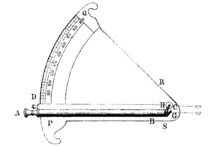
Isaac Newton's reflecting quadrant was invented around 1699. [1] A detailed description of the instrument was given to Edmond Halley, but the description was not published until after Halley's death in 1742. It is not known why Halley did not publish the information during his life, as this prevented Newton from getting the credit for the invention that is generally given to John Hadley and Thomas Godfrey.
One copy of this instrument was constructed by Thomas Heath (instrument maker) and may have been shown in Heath's shop window prior to its being published by the Royal Society in 1742. [2]
Newton's instrument used two mirrors, but they were used in an arrangement somewhat different from the two mirrors found in modern octants and sextants. The diagram on the right shows the configuration of the instrument. [3]
The 45° arc of the instrument (PQ), was graduated with 90 divisions of a half-degree each. Each such division was subdivided into 60 parts and each part further divided into sixths. This results in the arc being marked in degrees, minutes and sixths of a minute (10 seconds). Thus the instrument could have readings interpolated to 5 seconds of arc. This fineness of graduation is only possible due to the large size of the instrument - the sighting telescope alone was three to four feet long.
A sighting telescope (AB), three or four feet long, was mounted along one side of the instrument. A horizon mirror was fixed at a 45° angle in front of the telescope's objective lens (G). This mirror was small enough to allow the observer to see the image in the mirror on one side and to see directly ahead on the other. The index arm (CD) held an index mirror (H), also at 45° to the edge of the index arm. The reflective sides of the two mirrors nominally faced each other, so that the image seen in the first mirror is that reflected from the second.
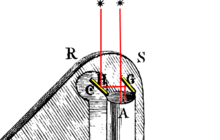
With the two mirrors parallel, the index reads 0°. The view through the telescope sees directly ahead on one side and the view from the mirror G sees the same image reflected from mirror H (see detail drawing to the right). When the index arm is moved from zero to a large value, the index mirror reflects an image that is in a direction away from the direct line of sight. As the index arm movement increases, the line of sight for the index mirror moves toward S (to the right in the detail image). This shows a slight deficiency with this mirror arrangement. The horizon mirror will block the view of the index mirror at angles approaching 90°.
The length of the sighting telescope seems remarkable, given the small size of the telescopes on modern instruments. This was likely Newton's choice of a way to reduce chromatic aberrations. Short–focal length telescopes, prior to the development of achromatic lenses, produced an objectionable degree of aberration, so much so that it could affect the perception of a star's position. Long focal lengths were the solution, and this telescope would likely have had both a long–focal length objective lens and a long–focal length eyepiece. This would decrease aberrations without excessive magnification.
Two men independently developed the octant around 1730: John Hadley (1682–1744), an English mathematician, and Thomas Godfrey (1704–1749), a glazier in Philadelphia. While both have a legitimate and equal claim to the invention, Hadley generally gets the greater share of the credit. This reflects the central role that London and the Royal Society played in the history of scientific instruments in the eighteenth century.
Two others who created octants during this period were Caleb Smith, an English insurance broker with a strong interest in astronomy (in 1734), and Jean-Paul Fouchy, a mathematics professor and astronomer in France (in 1732).

Hadley produced two versions of the reflecting quadrant. Only the second is well known and is the familiar octant.
Hadley's first reflecting quadrant was a simple device with a frame spanning a 45° arc. In the image at the right, from Hadley's article in the Philosophical Transactions of the Royal Society, [4] you can see the nature of his design. A small sighting telescope was mounted on the frame along one side. One large index mirror was mounted at the point of rotation of the index arm. A second, smaller horizon mirror was mounted on the frame in the line of sight of the telescope. The horizon mirror allows the observer to see the image of the index mirror in one half of the view and to see a distant object in the other half. A shade was mounted at the vertex of the instrument to allow one to observe a bright object. The shade pivots to allow it to move out of the way for stellar observations.
Observing through the telescope, the navigator would sight one object directly ahead. The second object would be seen by reflection in the horizon mirror. The light in the horizon mirror is reflected from the index mirror. By moving the index arm, the index mirror can be made to reveal any object up to 90° from the direct line of sight. When both objects are in the same view, aligning them together allows the navigator to measure the angular distance between them.
Very few of the original reflecting quadrant designs were ever produced. One, constructed by Baradelle, is in the collection of the Musée de la Marine, Paris. [5]

Hadley's second design had the form familiar to modern navigators. The image to the right, also taken from his Royal Society publication, [4] shows the details.
He placed an index mirror on the index arm. Two horizon mirrors were provided. The upper mirror, in the line of the sighting telescope, was small enough to allow the telescope to see directly ahead as well as seeing the reflected view. The reflected view was that of the light from the index mirror. As in the previous instrument, the arrangement of the mirrors allowed the observer to simultaneously see an object straight ahead and to see one reflected in the index mirror to the horizon mirror and then into the telescope. Moving the index arm allowed the navigator to see any object within 90° of the direct view.
The significant difference with this design was that the mirrors allowed the instrument to be held vertically rather than horizontally and it provided more room for configuring the mirrors without suffering from mutual interference.
The second horizon mirror was an interesting innovation. The telescope was removable. It could be remounted so that the telescope viewed the second horizon mirror from the opposite side of the frame. By mounting the two horizon mirrors at right angles to each other and permitting the movement of the telescope, the navigator could measure angles from 0 to 90° with one horizon mirror and from 90° to 180° with the other. This made the instrument very versatile. For unknown reasons, this feature was not implemented on octants in general use.
Comparing this instrument to the photo of a typical octant at the top of the article, one can see that the only significant differences in the more modern design are:

Caleb Smith, an English insurance broker with a strong interest in astronomy, had created an octant in 1734. He called it an Astroscope or Sea-Quadrant. [6] His used a fixed prism in addition to an index mirror to provide reflective elements. Prisms provide advantages over mirrors in an era when polished speculum metal mirrors were inferior and both the silvering of a mirror and the production of glass with flat, parallel surfaces was difficult.
In the drawing to the right, the horizon element (B) could be a mirror or a prism. On the index arm, the index mirror (A) rotated with the arm. A sighting telescope was mounted on the frame (C). The index did not use a vernier or other device at the scale (D). Smith called the instrument's index arm a label, in the manner of Elton for his mariner's quadrant. [7]
Various design elements of Smith's instrument made it inferior to Hadley's octant and it was not used significantly. [5] For example, one problem with the Astroscope was that angle of the observer's line of sight. By looking down, he had greater difficulty in observing than an orientation with his head in a normal orientation.
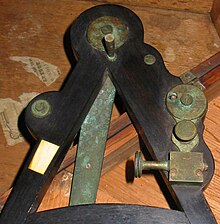
The octant provided a number of advantages over previous instruments.
The sight was easy to align because the horizon and the star seem to move together as the ship pitched and rolled. This also created a situation where the error in observation was less dependent on the observer, as they could directly see both objects at once.
With the use of the manufacturing techniques available in the 18th century, the instruments were capable of reading very accurately. The size of the instruments was reduced with no loss of accuracy. An octant could be half the size of a Davis quadrant with no increase in error.
Using shades over the light paths, one could observe the sun directly, while moving the shades out of the light path allowed the navigator to observe faint stars. This made the instrument usable both night and day.
By 1780, the octant and sextant had almost completely displaced all previous navigational instruments. [5]
Early octants were constructed primarily in wood, with later versions incorporating ivory and brass components. The earliest mirrors were polished metal, since the technology to produce silvered glass mirrors with flat, parallel surfaces was limited. As glass polishing techniques improved, glass mirrors began to be provided. These used coatings of mercury-containing tin amalgam; coatings of silver or aluminum were not available until the 19th century. The poor optical quality of the early polished speculum metal mirrors meant that telescopic sights were not practical. For that reason, most early octants employed a simple naked-eye sighting pinnula instead.
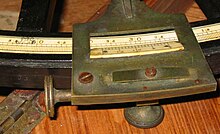
Early octants retained some of the features common to backstaves, such as transversals on the scale. However, as engraved, they showed the instrument to have an apparent accuracy of only two minutes of arc while the backstaff appeared to be accurate to one minute. The use of the vernier scale allowed the scale to be read to one minute, so improved the marketability of the instrument. This and the ease in making verniers compared to transversals, lead to adoption of the vernier on octants produced later in the 18th century. [8]
Octants were produced in large numbers. In wood and ivory, their relatively low price compared to an all-brass sextant made them a popular instrument. The design was standardized with many manufacturers using the identical frame style and components. Different shops could make different components, with woodworkers specializing in frames and others in the brass components. For example, Spencer, Browning and Rust, a manufacturer of scientific instruments in England from 1787 to 1840 (operating as Spencer, Browning and Co. after 1840) used a Ramsden dividing engine to produce graduated scales in ivory. These were widely used by others and the SBR initials could be found on octants from many other manufacturers. [9]
Examples of these very similar octants are in the photos in this article. The image at the top is essentially the same instrument as the one in the detail photos. However, they are from two different instrument makers - the upper is labelled Crichton - London, Sold by J Berry Aberdeen while the detail images are of an instrument from Spencer, Browning & Co. London. The only obvious difference is the presence of horizon shades on the Crichton octant that are not on the other.
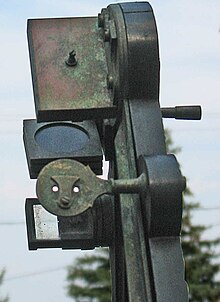
These octants were available with many options. A basic octant with graduations directly on the wood frame were least expensive. These dispensed with a telescopic sight, using a single- or double-holed sighting pinnula instead. Ivory scales would increase the price, as would the use of a brass index arm or a vernier.
In 1767 the first edition of The Nautical Almanac tabulated lunar distances, enabling navigators to find the current time from the angle between the Sun and the Moon. This angle is sometimes larger than 90°, and thus not possible to measure with an octant. For that reason, Admiral John Campbell, who conducted shipboard experiments with the lunar distance method, suggested a larger instrument and the sextant was developed. [10]
From that time onward, the sextant was the instrument that experienced significant development and improvements and was the instrument of choice for naval navigators. The octant continued to be produced well into the 19th century, though it was generally a less accurate and less expensive instrument. The lower price of the octant, including versions without telescope, made it a practical instrument for ships in the merchant and fishing fleets.
One common practice among navigators up to the late nineteenth century was to use both a sextant and an octant. The sextant was used with great care and only for lunars, while the octant was used for routine meridional altitude measurements of the Sun every day. [7] This protected the very accurate and pricier sextant, while using the more affordable octant where it performs well.
From the early 1930s through the end of the 1950s, several types of civilian and military bubble octant instruments were produced for use aboard aircraft. [11] All were fitted with an artificial horizon in the form of a bubble, which was centered to align the horizon for a navigator flying thousands of feet above the Earth; some had recording features. [12]
Use and adjustment of the octant is essentially identical to the navigator's sextant.
Hadley's was not the first reflecting quadrant. Robert Hooke invented a reflecting quadrant in 1684 [13] and had written about the concept as early as 1666. [14] Hooke's was a single-reflecting instrument. [14] Other octants were developed by Jean-Paul Fouchy and Caleb Smith in the early 1730s, however, these did not become significant in the history of navigation instruments.

Navigation is a field of study that focuses on the process of monitoring and controlling the movement of a craft or vehicle from one place to another. The field of navigation includes four general categories: land navigation, marine navigation, aeronautic navigation, and space navigation.

A sextant is a doubly reflecting navigation instrument that measures the angular distance between two visible objects. The primary use of a sextant is to measure the angle between an astronomical object and the horizon for the purposes of celestial navigation.

Celestial navigation, also known as astronavigation, is the practice of position fixing using stars and other celestial bodies that enables a navigator to accurately determine their actual current physical position in space or on the surface of the Earth without relying solely on estimated positional calculations, commonly known as "dead reckoning." Celestial navigation is performed without using satellite navigation or other similar modern electronic or digital positioning means.

An alidade or a turning board is a device that allows one to sight a distant object and use the line of sight to perform a task. This task can be, for example, to triangulate a scale map on site using a plane table drawing of intersecting lines in the direction of the object from two or more points or to measure the angle and horizontal distance to the object from some reference point's polar measurement. Angles measured can be horizontal, vertical or in any chosen plane.

John Hadley was an English mathematician, and laid claim to the invention of the octant, two years after Thomas Godfrey claimed the same.

The Newtonian telescope, also called the Newtonian reflector or just a Newtonian, is a type of reflecting telescope invented by the English scientist Sir Isaac Newton, using a concave primary mirror and a flat diagonal secondary mirror. Newton's first reflecting telescope was completed in 1668 and is the earliest known functional reflecting telescope. The Newtonian telescope's simple design has made it very popular with amateur telescope makers.
The backstaff is a navigational instrument that was used to measure the altitude of a celestial body, in particular the Sun or Moon. When observing the Sun, users kept the Sun to their back and observed the shadow cast by the upper vane on a horizon vane. It was invented by the English navigator John Davis, who described it in his book Seaman's Secrets in 1594.
Navigational instruments are instruments used by nautical navigators and pilots as tools of their trade. The purpose of navigation is to ascertain the present position and to determine the speed, direction, etc. to arrive at the port or point of destination.

The term Jacob's staff is used to refer to several things, also known as cross-staff, a ballastella, a fore-staff, a ballestilla, or a balestilha. In its most basic form, a Jacob's staff is a stick or pole with length markings; most staffs are much more complicated than that, and usually contain a number of measurement and stabilization features. The two most frequent uses are:

The meridian circle is an instrument for timing of the passage of stars across the local meridian, an event known as a culmination, while at the same time measuring their angular distance from the nadir. These are special purpose telescopes mounted so as to allow pointing only in the meridian, the great circle through the north point of the horizon, the north celestial pole, the zenith, the south point of the horizon, the south celestial pole, and the nadir. Meridian telescopes rely on the rotation of the sky to bring objects into their field of view and are mounted on a fixed, horizontal, east–west axis.
In astronomy, sextants are devices depicting a sixth of a circle, used primarily for measuring the position of stars. There are two types of astronomical sextants, mural instruments and frame-based instruments.

A quadrant is an instrument used to measure angles up to 90°. Different versions of this instrument could be used to calculate various readings, such as longitude, latitude, and time of day. Its earliest recorded usage was in ancient India in Rigvedic times by Rishi Atri to observe a solar eclipse. It was then proposed by Ptolemy as a better kind of astrolabe. Several different variations of the instrument were later produced by medieval Muslim astronomers. Mural quadrants were important astronomical instruments in 18th-century European observatories, establishing a use for positional astronomy.
Reflecting instruments are those that use mirrors to enhance their ability to make measurements. In particular, the use of mirrors permits one to observe two objects simultaneously while measuring the angular distance between the objects. While reflecting instruments are used in many professions, they are primarily associated with celestial navigation as the need to solve navigation problems, in particular the problem of the longitude, was the primary motivation in their development.

An Elton's quadrant is a derivative of the Davis quadrant. It adds an index arm and artificial horizon to the instrument, and was invented by English sea captain John Elton, who patented his design in 1728 and published details of the instrument in the Philosophical Transactions of the Royal Society in 1732.

The Bris sextant is not a sextant proper, but is a small angle-measuring device that can be used for navigation. The Bris is, however, a true reflecting instrument which derives its high accuracy from the same principle of double reflection which is fundamental to the octant, the true sextant, and other reflecting instruments. It differs from other sextants primarily in being a fixed angle sextant, capable of measuring a few specific angles.

Spencer, Browning & Rust was a London firm that manufactured instruments for navigational use during the 18th and 19th centuries. The predecessor company of Spencer and Browning was established by William Spencer and Samuel Browning in 1778, before they entered into partnership with Ebenezer Rust in 1784. After the death of Ebenezer Rust's son, the successor business was known as Spencer, Browning & Co. The firm of Spencer, Browning & Rust made a variety of navigational instruments, including octants and sextants.
Jonathan Sisson was a prominent English instrument maker, the inventor of the modern theodolite with a sighting telescope for surveying, and a leading maker of astronomical instruments.
The Greeks studied the results of the measurements of latitude by the explorer Pytheas who voyaged to Britain and beyond, as far as the Arctic Circle, in 325 BC. They used several methods to measure latitude, including the height of the Sun above the horizon at midday, measured using a gnōmōn ; the length of the day at the summer solstice, and the elevation of the Sun at winter solstice.
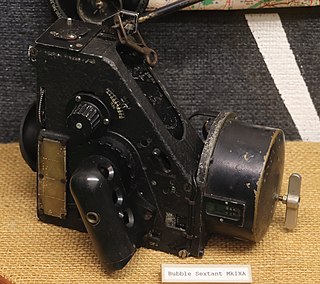
The bubble octant and bubble sextant are air navigation instruments. Although an instrument is called a "bubble sextant", it may actually be a bubble octant.
By this instrument the distance of the moon from any fixed star is thus observed; view the star through the perspicil by the direct light, and the moon by the reflexed, (or on the contrary;) and turn the index till the star touch the limb of the moon, and the index shall show on the brass limb of the instrument the distance of the star from the moon's limb; and though the instrument shake by the motion of the ship at sea, yet the moon and star will move together as if they did really touch one another in the heavens; so that an observation may be made as exactly at sea as at land. And by the same instrument, may be observed exactly the altitudes of the moon and stars, by bringing them to the horizon; and thereby the latitude and times of observation may be determined more exactly than by the ways now in use.Vol. 42 at archive.org
![]() Media related to Octants at Wikimedia Commons
Media related to Octants at Wikimedia Commons